Cy Twombly: Leda and the Swan, 1962
The present analysis of one of Cy Twombly's works has been preceded with an overview of
critical opinions on the art of the American abstract painter and sculptor who sińce the 1950s has
been based in the Eternal City. The views of Herner Bastian, Roland Barthes and Barbara Rose
were enhanced by the critical opinions of art critics and journalists voiced in the discussion that
aroused after the artist's retrospective exhibition Cycles and Seasons, on show in the London
Tate Modern from June to September 2008.
The subject of the present paper is the Leda and the Swan (1962), and the main focus of the
article is the formal analysis of the painting done by the artist who in the 1950s had chosen an
alternative artistic path: on the one hand, to a lesser degree directed by the pnnciple of accident,
and on the other, more balanced than the American abstraction with its then dominant role of
action painting. A careful examination of the painting's composition, its texture, format, line pat-
terns, colour scheme and gradation of colour hues, as well as the variety of techniąues employed
by the artist, was combined here with an attempt at interpreting the contents inscribed in the
work in ąuestion. Just like other of Twombly's works, this painting is enigmatic and ambiguous.
The contextual analysis of the painting revealed elements deeply rooted in tradition, which the
artist employed while creating contemporary works of art. Further, the examination showed the
Twombly's interest in European and Far Eastern cultures, an interest bordering on fascination,
a feature characteristic for the artist. The specific aura of the painting created under the sign of
Eros is the result of employing delicate colours, lines and the calligraphed text inscribed in the
composition. This multiplicity and variety of different elements biur the borders between image,
sign, notion and word. The ancient myth, which underlies the "painted" narrative, was shown here
as an important interpretative context, and allowed for employing anthropological perspective
when looking at the artwork emanating with sensuality. By emphasising the intimate contact
of the artist-medium with his work in which the mythical story is seen anew from the angle of
Goethe's Faust or the "voyeuristic" projects, the Leda and the Swan can be interpreted as a text
of culture written in a specific "language" of internal speech, which denotes the proximity of
feelings of the author of the painting with those of its beholder.
164
The present analysis of one of Cy Twombly's works has been preceded with an overview of
critical opinions on the art of the American abstract painter and sculptor who sińce the 1950s has
been based in the Eternal City. The views of Herner Bastian, Roland Barthes and Barbara Rose
were enhanced by the critical opinions of art critics and journalists voiced in the discussion that
aroused after the artist's retrospective exhibition Cycles and Seasons, on show in the London
Tate Modern from June to September 2008.
The subject of the present paper is the Leda and the Swan (1962), and the main focus of the
article is the formal analysis of the painting done by the artist who in the 1950s had chosen an
alternative artistic path: on the one hand, to a lesser degree directed by the pnnciple of accident,
and on the other, more balanced than the American abstraction with its then dominant role of
action painting. A careful examination of the painting's composition, its texture, format, line pat-
terns, colour scheme and gradation of colour hues, as well as the variety of techniąues employed
by the artist, was combined here with an attempt at interpreting the contents inscribed in the
work in ąuestion. Just like other of Twombly's works, this painting is enigmatic and ambiguous.
The contextual analysis of the painting revealed elements deeply rooted in tradition, which the
artist employed while creating contemporary works of art. Further, the examination showed the
Twombly's interest in European and Far Eastern cultures, an interest bordering on fascination,
a feature characteristic for the artist. The specific aura of the painting created under the sign of
Eros is the result of employing delicate colours, lines and the calligraphed text inscribed in the
composition. This multiplicity and variety of different elements biur the borders between image,
sign, notion and word. The ancient myth, which underlies the "painted" narrative, was shown here
as an important interpretative context, and allowed for employing anthropological perspective
when looking at the artwork emanating with sensuality. By emphasising the intimate contact
of the artist-medium with his work in which the mythical story is seen anew from the angle of
Goethe's Faust or the "voyeuristic" projects, the Leda and the Swan can be interpreted as a text
of culture written in a specific "language" of internal speech, which denotes the proximity of
feelings of the author of the painting with those of its beholder.
164




